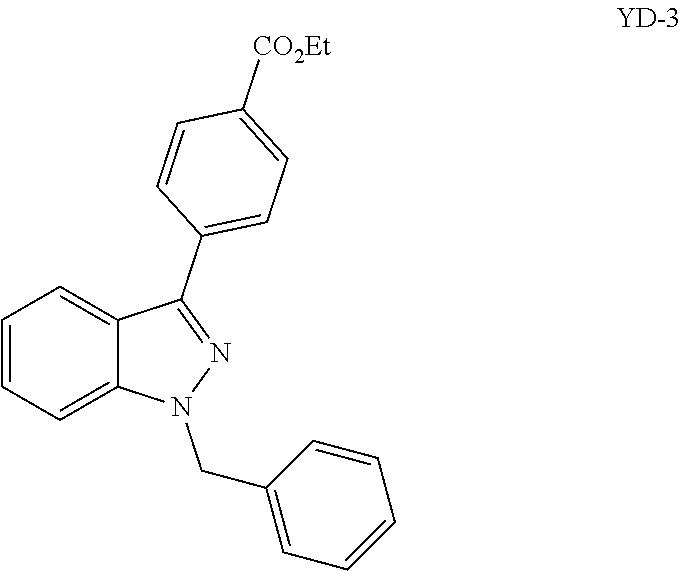Substituted and fused 6-membered protease activated receptor 4 (par-4) antagonists
a protease activation and protease technology, applied in the field of substituting and fusion, can solve the problems of increasing the risk of intracranial hemorrhage without improvement in major vascular events, increasing the risk of bleeding as well as partial efficacy, and increasing the risk of intracranial hemorrhage, etc., to achieve the effect of reducing the inflammatory response, increasing the generation of thrombin and coagulation factor activation, and increasing tissue factor
- Summary
- Abstract
- Description
- Claims
- Application Information
AI Technical Summary
Benefits of technology
Problems solved by technology
Method used
Image
Examples
examples / experimental
E. EXAMPLES / EXPERIMENTAL
[0229]Some of the compounds of the instant invention have at least one asymmetric center. Additional asymmetric centers may be present depending upon the nature of the various substituents on the molecule. Compounds with asymmetric centers give rise to enantiomers (optical isomers), diastereomers (configurational isomers) or both, and it is intended that all of the possible enantiomers and diastereomers in mixtures and as pure or partially purified compounds are included within the scope of this invention. The present invention is meant to encompass all such isomeric forms of these compounds.
[0230]The independent syntheses of the enantiomerically or diastereomerically enriched compounds, or their chromatographic separations, may be achieved as known in the art by appropriate modification of the methodology disclosed herein. Their absolute stereochemistry may be determined by the x-ray crystallography of crystalline products or crystalline intermediates that a...
example 1 (
Table 1, B12)
Preparation of 2-methoxy-6-(p-tolyl)imidazo[2,1-b][1,3,4]thiadiazole
[0246]
[0247]Step 1. A mixture of commercially available 2-bromo-1-(p-tolyl)ethan-1-one (2.35 mmol) and 5-bromo-1,3,4-thiadiazol-2-amine (3.52 mmol) were dissolved in CH3CN / IPA (1:1; 9.4 mL) in a microwave vial that was sealed and heated to 80° C. for 18 hr. Next, the vial was placed in a Microwave for 30 minutes at 150° C. The solvent was evaporated and the mixture was re-suspended in DCM (20 mL), washed with saturated NaHCO3 (20 mL), brine, dried over magnesium sulfate and filtered. The organic layer was concentrated under reduced pressure onto celite and loaded onto a 3 inch silica plug and purified using Teledyne ISCO Combi-Flash system (solid loading, 100% DCM, 10 min run) to afford 2-bromo-6-(p-tolyl)imidazo[2,1-b][1,3,4]thiadiazole (1.70 mmol) in 72% yield. LC-MS [M+H]=294 / 296, RT=1.174; 1H NMR (400 MHz, CDCl3) δ 7.98 (s, 1H), 7.68-7.70 (d, J=8.16 Hz, 2H), 7.21-7.23 (d, J=8.03 Hz, 2H), 2.38 (s, 3H...
example 2 (
Table 1, B43)
Preparation of 2-Methoxy-6-(4-((2-phenylthiazol-4-yl)methoxy)phenyl)imidazo[2,1-b][1,3,4]thiadiazole
[0251]
[0252]A mixture of 2-bromo-1-(4-((2-phenylthiazol-4-yl)methoxy)phenyl)ethan-1-one (0.37 mmol, Intermediate A1) and 5-bromo-1,3,4-thiadiazol-2-amine (0.56 mmol) was dissolved in 2 mL of IPA / ACN (1:1) in a microwave vial. The vial was capped then heated to 40° C. for 18 hr and then the reaction was stirred at 150° C. for 30 minutes in a Microwave reactor. After consumption of the starting material as determined by LCMS analysis (LC-MS [M+H]=469 / 471, RT=1.384), the reaction was diluted with DCM and washed sequentially with saturated NaHCO3 and brine. The organic layer was dried with magnesium sulfate and filtered to remove solids. The solvent was removed under vacuum and the crude product was taken up in 10 mL DCM / MeOH (3:1) and treated with a 25 wt. % solution of MeONa (1.3 mmol) in MeOH added in one portion and the mixture was stirred at room temperature for 1 hr. Th...
PUM
| Property | Measurement | Unit |
|---|---|---|
| Fraction | aaaaa | aaaaa |
| Fraction | aaaaa | aaaaa |
| Fraction | aaaaa | aaaaa |
Abstract
Description
Claims
Application Information
 Login to View More
Login to View More - R&D
- Intellectual Property
- Life Sciences
- Materials
- Tech Scout
- Unparalleled Data Quality
- Higher Quality Content
- 60% Fewer Hallucinations
Browse by: Latest US Patents, China's latest patents, Technical Efficacy Thesaurus, Application Domain, Technology Topic, Popular Technical Reports.
© 2025 PatSnap. All rights reserved.Legal|Privacy policy|Modern Slavery Act Transparency Statement|Sitemap|About US| Contact US: help@patsnap.com



